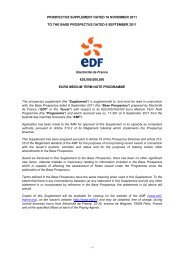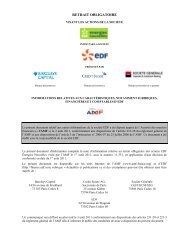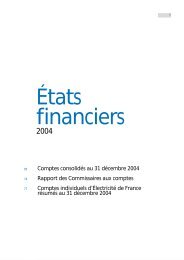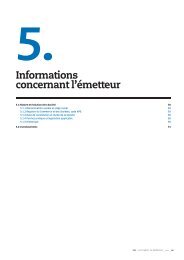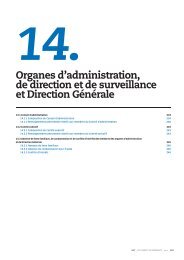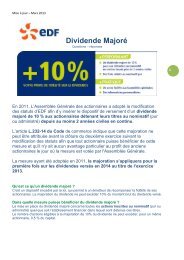Under the Euro Medium Term Note Programme ... - Finance - EDF
Under the Euro Medium Term Note Programme ... - Finance - EDF
Under the Euro Medium Term Note Programme ... - Finance - EDF
Create successful ePaper yourself
Turn your PDF publications into a flip-book with our unique Google optimized e-Paper software.
Risk Factors<br />
having power to tax, <strong>the</strong> Issuer may redeem all outstanding <strong>Note</strong>s in accordance with <strong>the</strong><br />
<strong>Term</strong>s and Conditions.<br />
In addition, if in <strong>the</strong> case of any particular Tranche <strong>the</strong> relevant Final <strong>Term</strong>s specify that <strong>the</strong><br />
<strong>Note</strong>s are redeemable at <strong>the</strong> Issuer's option in certain o<strong>the</strong>r circumstances <strong>the</strong> Issuer may<br />
choose to redeem <strong>the</strong> <strong>Note</strong>s at times when prevailing interest rates may be relatively low.<br />
During a period when <strong>the</strong> Issuer may elect, or has elected, to redeem <strong>Note</strong>s, such <strong>Note</strong>s<br />
may feature a market value not substantially above <strong>the</strong> price at which <strong>the</strong>y can be redeemed.<br />
In such circumstances an investor may not be able to reinvest <strong>the</strong> redemption proceeds in a<br />
comparable security at an effective interest rate as high as that of <strong>the</strong> relevant <strong>Note</strong>s.<br />
Fixed Rate <strong>Note</strong>s<br />
Investment in <strong>Note</strong>s which bear interest at a fixed rate involves <strong>the</strong> risk that subsequent<br />
changes in market interest rates may adversely affect <strong>the</strong> value of <strong>the</strong> relevant Tranche.<br />
Floating Rate <strong>Note</strong>s<br />
Investment in <strong>Note</strong>s which bear interest at a floating rate comprise (i) a reference rate and<br />
(ii) a margin to be added or subtracted, as <strong>the</strong> case may be, from such base rate. Typically,<br />
<strong>the</strong> relevant margin will not change throughout <strong>the</strong> life of <strong>the</strong> <strong>Note</strong>s but <strong>the</strong>re will be a<br />
periodic adjustment (as specified in <strong>the</strong> relevant Final <strong>Term</strong>s) of <strong>the</strong> reference rate<br />
(e.g., every three months or six months) which itself will change in accordance with general<br />
market conditions. Accordingly, <strong>the</strong> market value of floating rate <strong>Note</strong>s may be volatile if<br />
changes, particularly short-term changes, to market interest rates evidenced by <strong>the</strong> relevant<br />
reference rate can only be reflected in <strong>the</strong> interest rate of <strong>the</strong>se <strong>Note</strong>s upon <strong>the</strong> next periodic<br />
adjustment of <strong>the</strong> relevant reference rate.<br />
Inverse Floating Rate <strong>Note</strong>s<br />
Inverse floating rate <strong>Note</strong>s have an interest rate equal to a fixed base rate minus a rate<br />
based upon a reference rate. The market value of such <strong>Note</strong>s typically is more volatile than<br />
<strong>the</strong> market value of o<strong>the</strong>r conventional floating rate debt securities based on <strong>the</strong> same<br />
reference rate (and with o<strong>the</strong>rwise comparable terms). Inverse floating rate <strong>Note</strong>s are more<br />
volatile because an increase in <strong>the</strong> reference rate not only decreases <strong>the</strong> interest rate of <strong>the</strong><br />
<strong>Note</strong>s, but may also reflect an increase in prevailing interest rates, which fur<strong>the</strong>r adversely<br />
affects <strong>the</strong> market value of <strong>the</strong>se <strong>Note</strong>s.<br />
Fixed to Floating Rate <strong>Note</strong>s<br />
Fixed/Floating Rate <strong>Note</strong>s may bear interest at a rate that <strong>the</strong> Issuer may elect to convert<br />
from a fixed rate to a floating rate, or from a floating rate to a fixed rate. The Issuer's ability to<br />
convert <strong>the</strong> interest rate will affect <strong>the</strong> secondary market and <strong>the</strong> market value of such <strong>Note</strong>s<br />
since <strong>the</strong> Issuer may be expected to convert <strong>the</strong> rate when it is likely to produce a lower<br />
overall cost of borrowing. If <strong>the</strong> Issuer converts from a fixed rate to a floating rate, <strong>the</strong> spread<br />
on <strong>the</strong> Fixed/ Floating Rate <strong>Note</strong>s may be less favourable than <strong>the</strong>n prevailing spreads on<br />
comparable Floating Rate <strong>Note</strong>s tied to <strong>the</strong> same reference rate. In addition, <strong>the</strong> new floating<br />
rate at any time may be lower than <strong>the</strong> rates on o<strong>the</strong>r <strong>Note</strong>s. If <strong>the</strong> Issuer converts from a<br />
floating rate to a fixed rate, <strong>the</strong> fixed rate may be lower than <strong>the</strong>n prevailing rates on its<br />
<strong>Note</strong>s.<br />
-32 -



